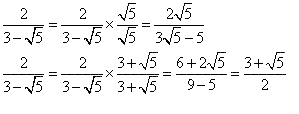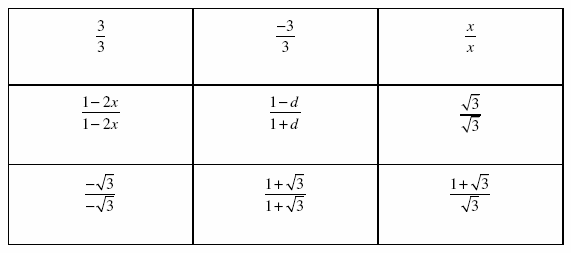Mathematics Developmental Continuum P-10 – Number
Mathematics Continuum Home | Number | Space | Measurement, chance and data | Structure | Working Mathematically
Rationalising Surds
Supporting materials
- Related Progression Point
- Developmental Overview of Working Mathematically (PDF - 31Kb)
- Developmental Overview of Structure (PDF - 35Kb)
Indicator of Progress
At this level students can rationalise expressions with surds in the denominator as in Example 1a below.
Before this level students can simplify surds as in Example 1b below and add, subtract and multiply expressions containing surds without using technology.
More advanced students will be able to rationalise expressions such as Example 1c below.

Illustration 1: Rationalising surds uses fraction knowledge
Students will experience difficulty in rationalising surds if they have difficulty multiplying and simplifying fractions.
Further reading – The development of surd ideas: 5.5.
Students need to understand that multiplication by one, in many forms (such as in Example 1d below) gives an equivalent surd (i.e. the value is not changed by this process).

Illustration 2: Rationalising more complex surds
First students will rationalise surds such as Example 2a below, and at a more advanced level, they will rationalise more complex surds such as Example 2b. If students focus only on part of the denominator when rationalising Example 2b , they may multiply by 1 or -1, disguised as in Example 2c or Example 2d, leaving a surd term remaining in the denominator.


Failure in rationalising
Success in rationalising
Teaching Strategies
These activities aim to provide a motivation for the process of rationalising and exploration to show the equivalence of the rationalised and un-rationalised expressions. Students can check their exact calculations at all stages with approximate calculator calculations.
Activity 1: Rationalise provides an exploration, a
motivation and practice at rationalising simple surds.
Activity
2: Rationalising complex surds provides an exploration and
practice for more complex surds, requiring good fraction and algebra skills.
Activity
3: Golden rectangle provides a context for practising
calculations with surds. Calculating side lengths requires addition and
subtraction, calculating areas requires multiplication and, for advanced
students, showing that all the rectangles are the same shape requires division
and rationalising complex surd expressions.
Activity 1: Rationalise
This activity has three components where students gradually build up to rationalising complex surds.
Step 1: Identify one as a fraction in many disguises
This
short introduction quickly reviews fractions equal to one, extending beyond
familiar fractions. In pairs get students to identify which of the following
are equal to one and explain why. Students could also be asked to give some
other fractions equal to one and containing at least one surd.

Step 2: Create equivalent fractions
Begin with any
simple surd and multiply it by a fraction equal to 1 many times, getting a
sequence of expressions, as shown below. Students can deduce that these will
all have the same value, and calculate them on the calculator to check. In the
case below the value is 0.707… Repeat with other simple surd expressions.

Step 3: Provide a motivation for rationalising
Rationalisation
involves rewriting a surd so that the denominator does not contain a surd
term. In this process an equivalent surd (one with the same value) is
produced. Note the similarity with fraction terminology.
Show students why rationalisation was useful in the past. Get some students to calculate Example 5a below, by dividing 1 by the square root of 2 by hand, and other students to calculate Example 5c by dividing the square root of 2 by 2. Compare the ease of calculating the rationalised expression over the un-rationalised expression. They both have the same numerical value of 0.707…
Mention that rationalisation of surds is one of many conventions of good mathematical writing style, so textbooks and computer algebra technology will normally rationalise surds before presenting answers.

Step 4: Broaden the range of expressions
Show students
how to rationalise an expression such as that in Example 6a, emphasising that
the purpose is to rewrite this number so that the denominator does not contain
a surd term. Revisit the idea that multiplying by 1 (in the form of Example
6b) produces the same number, but in the form of Example 6c.

Now ask students to say by what fraction they would multiply surds such as those shown below in order to rationalise the surds.

Discuss answers. For example, in the second expression students may think that they should multiply top and bottom by 2 times the square root of 3, which would give the correct result, but needs an extra ‘cancelling’ step to get the simplest form.
Step 5: Provide more practice
Start with examples such
as Example 8a or Example 8b and then move to situations where students can
also cancel fractions to give simplest form, such as Example 8c, 8d and 8e.

Activity 2. Rationalising complex surds
Step 1: Searching for a strategy
Advanced students can
rationalise more complex expressions involving surds. In pairs ask students to
attempt to rationalise Example 9a. Encourage students to focus on the purpose
of rationalisation. The goal is to produce an equivalent expression without a
surd term in the denominator. Discuss students’ approaches, noting:
- strategies used by students
- why multiplying by Example 9b doesn’t help
- why multiplying by Example 9c doesn’t help (it gives the perfect square in Example 9d in the denominator and so will still have a surd term when expanded).
- the use of difference of perfect squares strategy to give a denominator without a surd term.
The discussion can help students think about reasons why they make particular decisions when rationalising, which will hopefully help students to choose fractions wisely.

Step 2: Practising rationalising more complex surds.
Provide
a range of examples where students need to think about the multiplier, and may
have to cancel fractions, rather than just follow patterns and change numbers
in a rule to rationalise. Include examples where the surd is written first in
the denominator and where it is written second, as shown below.

Providing this range of different forms that students have to deal with will be helpful in dealing with a variety of problems, helps them to focus on the process and also helps students get used to dealing with different forms, which is useful when using technology.
Activity 3: Golden rectangle
In this activity students practise surd calculations as they explore the golden rectangle.
A golden rectangle is a famous geometric shape. It has the property that if a square is cut from one end, then the remaining rectangle is geometrically similar to the initial golden rectangle, and so is another smaller golden rectangle.
Golden rectangle investigation (PDF - 67Kb) – provide this resource sheet to students. The first two diagrams from the worksheet are shown below:

To do the activity students need to be able to determine each side length of the increasingly smaller golden rectangles at each stage. They need to make links with the previous rectangle to do this. It is useful to spend some time initially to make sure that students can see how each successive diagram relates to the next one (a square is cut off).
Start with the large rectangle (the yellow rectangle is coloured within this). Its longer side length is shown in Example 11a and the shorter side length is Example 11b. Students then fill in its area and the ratio of its side lengths (longer over shorter).
Now they need to find the unknown side lengths for the yellow rectangle. They need to note that the longest side of the yellow rectangle is the shortest side of the original rectangle; therefore it has a length of Example 11b. To work out the shorter side of the yellow rectangle students need to recognise that the uncoloured square has side length Example 11b and so the length of the shorter side of the yellow rectangle will be as in Example 11c. Students can then perform the surd calculations to fill in the table. The length of the unknown side in the next rectangle uses the same logic as that for the yellow rectangle and students need to make this link.
Students can check their surd calculations by taking measurements using the GSP file available from the referenced website below, or they can use a ruler to measure these from the second page of the worksheet. Take care in photocopying the resource sheet so that the measurements are preserved.

References
RITEMATHS project (http://extranet.edfac.unimelb.edu.au/DSME/RITEMATHS/) – The Golden Rectangle activity is from RITEMATHS project at The University of Melbourne.